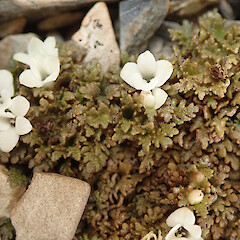Veronica cheesemanii subsp. cheesemanii
Common name
Cheeseman’s parahebe, Cheeseman’s speedwell
Synonyms
Parahebe cheesemanii (Benth.) W.R.B.Oliv., Parahebe cheesemanii (Benth.) W.R.B.Oliv. subsp. cheesemanii
Family
Plantaginaceae
Flora category
Vascular – Native
Endemic taxon
Yes
Endemic genus
No
Endemic family
No
Structural class
Herbs - Dicotyledons other than Composites
Chromosome number
2n = 42
Current conservation status
The conservation status of all known New Zealand vascular plant taxa at the rank of species and below were reassessed in 2017 using the New Zealand Threat Classification System (NZTCS) – more information about this can be found on the NZTCS website. This report includes a statistical summary and brief notes on changes since 2012 and replaces all previous NZTCS lists for vascular plants.
Please note, threat classifications are often suggested by authors when publications fall between NZTCS assessment periods – an interim threat classification status has not been assessed by the NZTCS panel.
- Conservation status of New Zealand indigenous vascular plants, 2017 . 2018. Peter J. de Lange, Jeremy R. Rolfe, John W. Barkla, Shannel P. Courtney, Paul D. Champion, Leon R. Perrie, Sarah M. Beadel, Kerry A. Ford, Ilse Breitwieser, Ines Schönberger, Rowan Hindmarsh-Walls, Peter B. Heenan and Kate Ladley. Department of Conservation. Source: NZTCS and licensed by DOC for reuse under the Creative Commons Attribution 4.0 International licence.
2017 | Not Threatened
Previous conservation statuses
2012 | Not Threatened
2009 | Not Threatened
2004 | Not Threatened
Distribution
Endemic. New Zealand. South Island (North-West Nelson, Richmond Range, Raglan Range, and Nelson Lakes National Park.
Habitat
Alpine. A species of fine-grained, stable screes and their associated grit soils.
Detailed description
Cushion-forming subshrub, 10-40 mm tall. Stem and branchlets brown. Branches prostrate to ascending. Vegetative internodes 1-12 mm long. Stem pubescence uniform, eglandular pubescent. Leaves erect to erecto-patent or recurved (in distal portion). Lamina ovate, deltoid, spathulate, or rhomboid, 2-5 × 2–3 mm. Upper surface of leaves dull bronze green or dark green. Under surface of leaves dull bronze green or dark green. Leaf hairs sparse, numerous or absent, or unicellular eglandular, uniseriate (0.5-1.0 mm long on petioles). Apex subacute to obtuse. Base cuneate. Margin minutely papillate or denticulate, pinnatifid, to bipinnatifid on basal lobes. Marginal teeth or lobes in 2-5 pairs. Petiole 3-6 mm long. Inflorescence 1-2(-3)-flowered, 2-10 mm long at fruiting. Indumentum of peduncle, rachis, and pedicels dense. Peduncle 0-20 mm long, eglandular-pubescent. Rachis 0-20 long, eglandular-pubescent. Bracts paired, opposite, obtuse or subacute, eglandular-hairy above and eglandular-hairy below, spathulate. Bract margins shallowly to deeply lobed. Pedicels patent at anthesis, straight at fruiting, 0-2 mm long, eglandular-pubescent. Flowers: Calyx 4(–5)-lobed, 4–7 mm long, lobes oblanceolate, oblong, spathulate, subacute to obtuse. Calyx hairs on both abaxial and adaxial surfaces, eglandular. Calyx lobe margins pinnatifid. Corolla white at anthesis. Nectar guides absent. Corolla throat same colour as lobes. Corolla 4-7 mm diameter. Corolla tube 3.5-7.0 × 1.5-2.0 mm, glabrous or shortly hairy outside. Corolla lobes glabrous or pubescent below. Posterior corolla lobe circular, elliptic or deltoid, obtuse, emarginate or divided in two, 2-3 × 2-4 mm. Lateral corolla lobes circular or elliptic, obtuse, flat, not enfolding stamens, 2-4 × 2-4 mm. Anterior corolla lobe elliptic, obtuse, 2.0-3.0 × 1.5-2.5 mm. Stamen filaments white, 1.5-2.0 mm long, not narrowed at base. Anthers pink to magenta, 1.0-1.5 mm long. Nectarial disc glabrous. Ovary ovoid &/or globose, obtuse, eglandular hairy, 1.0-1.5 mm long. Style 1.5–2.5 mm long. Capsules strongly flattened, emarginate to didymous, 3-4 × 3-4 mm, 2-3 mm thick, hairy. Hairs eglandular. Septicidal split of capsule extending 1/3 way to base (split to base in old capsules). Loculicidal split of capsule extending ¾ way to base or to base. Seeds ellipsoid to obovoid, pale brown to dark brown, 0.6-1.1 × 0.5-0.7 mm.
Similar taxa
Veronica cheesemanii is allied to V. spathulata from which it differs by being endemic to the South Island, by the pinnatifid rather than entire or bluntly toothed calyx lobes; usually solitary (rarely 2-3) rather than 2-8-flowered inflorescences; corolla tube 3.5–7.0 cf. 3.0-4.0 mm long (longer than rather than equal to the lobes); and by the capsule dehiscence being exclusively loculicidal. Veronica cheesemanii subsp, cheesemanii differs from subsp. flabellata by the ovate, deltoid, spathulate or rhomboid, pinnatifid leaves which are lobed ¾-way or more, and by the petiole hairs which are 0.5-1.0 mm long
Flowering
November - January
Flower colours
Red/Pink, White
Fruiting
December - April
Propagation technique
Difficult. Best grown in a rock garden or alpine house in a sunny position with a cool root run.
Etymology
veronica: Named after Saint Veronica, who gave Jesus her veil to wipe his brow as he carried the cross through Jerusalem, perhaps because the common name of this plant is ‘speedwell’. The name Veronica is often believed to derive from the Latin vera ‘truth’ and iconica ‘image’, but it is actually derived from the Macedonian name Berenice which means ‘bearer of victory’.
cheesemanii: Named after Thomas Frederick Cheeseman (1846 - 15 October 1923) who was a New Zealand botanist and naturalist who, in 1906, produced The Manual of the New Zealand Flora.
Where To Buy
Not Commercially Available
Attribution
Fact Sheet by P.J. de Lange (5 October 2006). Description adapted from Garnock-Jones and Lloyd (2003).
References and further reading
Garnock-Jones, P.J.; Lloyd, D.G. 2003: A taxonomic revision of Parahebe (Plantaginaceae) in New Zealand. New Zealand Journal of Botany 42: 181-232
NZPCN Fact Sheet citation
Please cite as: de Lange, P.J. (Year at time of access): Veronica cheesemanii subsp. cheesemanii Fact Sheet (content continuously updated). New Zealand Plant Conservation Network. https://www.nzpcn.org.nz/flora/species/veronica-cheesemanii-subsp-cheesemanii/ (Date website was queried)






